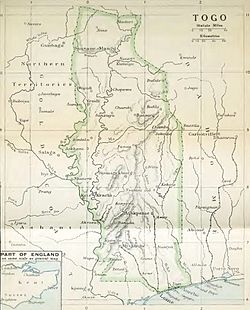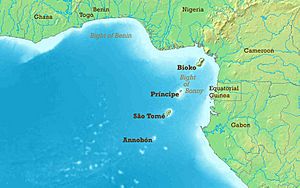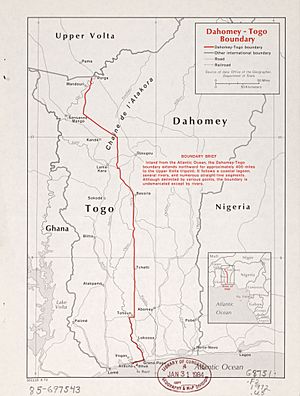Affair of Agbeluvoe facts for kids
Quick facts for kids Affair of Agbeluvoe |
|||||||
|---|---|---|---|---|---|---|---|
| Part of the Togoland Campaign of the First World War | |||||||
 Map of Togoland |
|||||||
|
|||||||
| Belligerents | |||||||
|
|||||||
| Commanders and leaders | |||||||
| H. B. Potter H. S. Collins |
|||||||
| Strength | |||||||
| 2,642 | 1,500 | ||||||
| Casualties and losses | |||||||
| 83 | 41 | ||||||
| Numbers and casualties relate to personnel in the colonial forces regardless of origin. | |||||||
The Affair of Agbeluvoe was a battle fought during the First World War on August 15, 1914. It took place in German Togoland (which is now the country of Togo). British soldiers from the West African Rifles fought against German police forces.
British troops had taken control of Lomé, the capital city of Togoland, which is on the coast. They were moving inland towards a powerful radio station at Kamina, about 100 miles (160 km) away. This radio station was very important for German communication. The only ways to get inland were by railway and road, which went through thick jungle.
German troops used two trains to travel south and try to stop the British and French invasion. However, they were surprised and attacked at Agbeluvoe. They lost many soldiers and had to run away. This left about 30 miles (48 km) of the railway line undamaged for the British to use. After a short break to get more supplies, the British continued their advance. They were joined by French soldiers called Tirailleurs Sénégalais. The German forces could only try to defend themselves one more time at the Affair of Khra a week later. The Germans then destroyed their radio station at Kamina on August 24/25 and surrendered the next day.
Contents
Background to the Battle
Why Togoland Was Important
When the First World War started, the British government decided it was important to control the seas. They also wanted to capture German areas that could help their enemies. German coaling stations (where ships got fuel) and wireless (radio) stations were key targets. These stations helped German ships and forces communicate.
Togoland, a German colony, was next to the British colony of Gold Coast (now Ghana). It had a very powerful wireless station at Kamina. This station was vital for Germany. It connected a German radio station near Berlin with German colonies in West Africa and South America. This meant Germany could send messages across the Atlantic Ocean.
German Plans and Allied Invasion
The German acting-Governor of Togoland, Major Hans-Georg von Doering, had a small force. He had about 152 paramilitary police, 416 local police, and 125 border guards. He did not have a regular army. When the war began, he suggested that Togoland stay neutral. But the British demanded that he surrender completely.
Von Doering then moved his forces away from Lomé, the capital, and the coast. He planned to retreat to the important Kamina wireless station. He sent a radio message about his plan, but he didn't encrypt it (code it). The British intercepted this message. This made the British decide to attack Kamina. British and French forces began moving into Togoland on August 12.
German Defenses and Train Attack
On August 6, 1914, the British and French told the Germans in Togoland to surrender. Anglo-French forces entered the colony and took Lomé without a fight on August 7. By August 12, the southern part of Togoland was under their control.
In the north, British and French troops also took towns like Yendi and Mango. In the south, the German police forces had pulled back to the Kamina wireless station, about 60 miles (100 km) inland. As the British and French moved towards Kamina, the German commanders tried to slow them down. They blew up bridges to block the roads.
The main British and French attacks came from the south. Here, good roads and railways made it easier for both sides to move. To stop the British West African Frontier Force, German commanders loaded about 200 soldiers onto two trains. They sent these trains south on August 15, 1914, to attack the Allies.
The Battle of Agbeluvoe
By August 14, the British had reached Tsevié without any fighting. Their scouts reported that the area south of Agbeluvoe was clear of German troops. The main British force gathered at Togblekove. A company of soldiers, led by Captain H. B. Potter, was sent ahead by road to Agbeluvoe. The rest of the main force followed on August 15.
When the main force reached Dawie, local people told them that a German train had shot at the station in Tsevié earlier that morning. At Tsevié, the British found that the train had gone north. They quickly moved to help Captain Potter's company.
Captain Potter's company had heard the train go south at 4:00 a.m. while they were stopped near Ekuni. A small group of soldiers was sent to cut off the train. The rest of the company continued to Agbeluvoe. A local person showed the small group where to go on the railway. Lieutenant H. S. Collins and his men piled stones and a heavy iron plate on the tracks. This was about 200 yards (180 m) north of a bridge at Ekuni, a village about 6 miles (10 km) south of Agbeluvoe. They then set up an ambush.
The Ambush and German Retreat
A second train, carrying Captain Georg Pfähler, the German commander, stopped just before the obstacle. It managed to reverse before the British ambushers could reach it. The rest of Captain Potter's company had heard the train pass. They set up another ambush and shot at the train's engine as it sped past them.
The different British groups then met up and moved to Agbeluvoe. There, they set up another block on the road and railway. Both German trains were now south of Agbeluvoe. German attacks bothered the British supply convoy for two hours before it reached the British position. The British position at Agbeluvoe was attacked several times from the south. More attacks happened overnight but were pushed back.
As the main British force got closer, the Germans pulled back towards their train. Eventually, they surrendered. The main British force, led by Colonel F. C. Bryant, had also fought a German group on the afternoon of August 15 at the Lila River. The Germans blew up the bridge there. They then retreated to a ridge and fought to delay the British until 4:30 p.m. Three German soldiers were killed. The British lost one soldier killed and three wounded. When the British continued their advance, they reached Ekuni. They found twenty railway carriages that had been derailed by the obstacle near the bridge.
Many German soldiers reportedly took off their uniforms, dropped their weapons, and ran into the bush when they saw the British ambush. The remaining Germans retreated north to Agbeluvoe, where more fighting happened. Captain Pfähler was killed there. A German prisoner later wrote that the German force at Agbeluvoe had two companies of local soldiers, led by Pfähler. An attempt to break through the British road and rail block failed. The Togolese troops refused orders and started shooting everywhere. Six Germans were killed, including Pfähler. The remaining troops fled. They could not contact Kamina, and news of the defeat was eventually brought by a German train driver who had been shot at in Agbeluvoe.
The next morning, Baron Cordelli von Fahnenfeldt, who designed the Kamina wireless station, and a German explosives expert were captured. The British column set off for Agbeluvoe. They met little resistance about halfway to the station and found a lot of abandoned equipment. They heard shooting until they were about 1 mile (1.6 km) from Agbeluvoe. There, they found that most of the roughly 200 German troops from the trains had been captured. They also captured two trains, wagons, a machine-gun, rifles, and much ammunition. The Germans who escaped were too discouraged to destroy anything, so 30 miles (48 km) of railway track were captured undamaged. The British lost six soldiers killed and 35 wounded. Some of the wounded had injuries that made the British suspect the Germans used soft-nosed bullets. This was later found to be partly true, as some German reservists had used their hunting ammunition.
Aftermath
Casualties
In the Affair of Agbeluvoe, the British had about 83 soldiers killed or wounded. The German forces had about 41 soldiers killed or wounded.
What Happened Next
On August 22, the Affair of Khra took place. This was another battle between the Anglo-French invaders and the Germans at the Khra River and in Khra village. The German forces had dug in and managed to stop the Anglo-French attack. However, when a new attack was planned for August 23, the Germans had already moved further inland towards Kamina.
By the end of the campaign, the Germans had given up six out of seven provinces. They had not blown up many bridges. Only the Khra river line, out of three possible water obstacles, had been defended. The British and French invaded very quickly with several columns. The Germans thought these columns were much larger than they actually were. Also, the German colonial government did not have much support from the local people. These problems were too big for the Germans to overcome. Togoland was then controlled by the British and French for the rest of the war.
Images for kids






